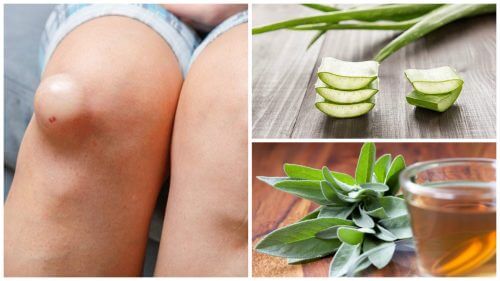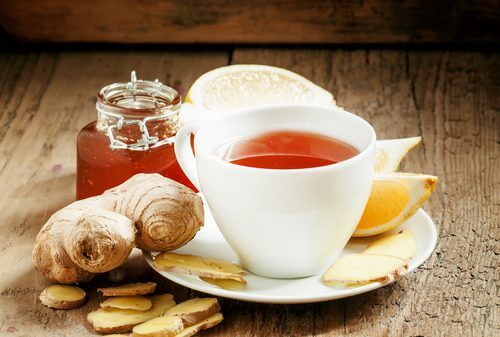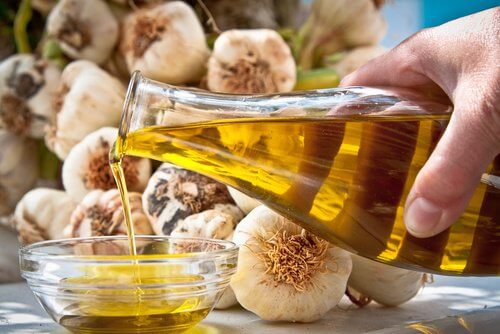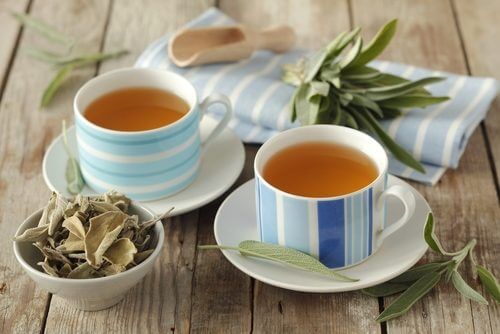Anti-inflammatory remedies to reduce knee fluid


Reviewed and approved by Doctor Carlos Fabián Avila
Occasionally, excess of knee fluid, injuries or diseases such as rheumatoid arthritis can cause a Baker’s cyst. This is a lump full of synovial fluid that leads to discomfort.
The synovial fluid is a type of fluid present in most joints of the body. Even though it’s necessary for lubrication, its excessive production increases inflammation.
Clearly, the accumulation of fluid in your knee can lead to inflammation, pain (of varying intensity) and moving difficulty. It’s not always serious, but timely treatment is key to prevent further complications.
You must consult a doctor so they can prescribe the most appropriate treatment. Additionally, you can consult them about the best adjunctive measures for you.
Anti-inflammatory remedies to reduce knee fluid
According to popular wisdom, some drinks can help relieve inflammation and, therefore, the pain caused by the accumulation of fluid in the knee. Mostly, these are infusions with ingredients that have a certain anti-inflammatory effect.
There’s no scientific evidence to prove these remedies are either useful in treating a Baker’s cyst or accelerate the recovery of discomfort or improve circulation or reduce swelling. However, some people use them as an adjunctive treatment.
1. Ginger and turmeric tea to reduce knee fluid

Ingredients
- 2 c. of water
- 1/2 tsp powdered ginger
- 1/2 tsp powdered turmeric
- 2 tbsp of honey
Preparation
- Firstly, put some water on to boil. When it starts to boil, add the ginger and turmeric powder.
- Then reduce the heat and let it steep for two more minutes.
- Finally, strain the liquid through a sieve. Sweeten it with honey and drink it.
Read more:5 Impressive Anti-inflammatory Remedies with Turmeric
2. Aloe vera-avocado drink to reduce knee fluid
Ingredients
- 1/2 avocado
- 3 tbsp of aloe vera gel
- Honey (optional)
Preparation
- Firstly, blend the avocado and the aloe vera.
- You can add a little water to make the mixture less thick.
- Process until homogenized.
- Serve and drink it.
- You may sweeten with honey.
3. Olive oil and garlic treatment

Ingredients
- 8 cloves of garlic
- 1/2 c. of olive oil
Preparation
- Firstly, cut the garlic cloves into thin slices and put them in a glass jar.
- Then add the olive oil. Be sure to completely cover the garlic.
- Finally, set it aside for a week. Then, take a tablespoon for breakfast every morning.
- Another alternative is to take a small amount of liquid and heat it up in the microwave. Then, massage it on your knees.
4. Dandelion tea
Ingredients
- 1 tbsp of dandelion
- 1 c. of water
Preparation
- Firstly, add the dandelion to boiling water and let it steep for 15 minutes.
- After this time, strain it in a colander and drink it.
- Finally, repeat this up to three times per day.
Read also Learn All About the Benefits of Dandelion
5. Sage compress

Ingredients
- 3 tbsp of sage
- 1 c. of water
Preparation
- First, add the sage to boiling water. Once it has infused well, soak a clean bandage in the liquid.
- After this, apply the compress directly onto the affected knee. Leave it there for 20 minutes.
- Finally, repeat the application each night before going to bed.
Final note
Homemade anti-inflammatory remedies can provide relief in some cases, but they’re not necessary, on their own, to eliminate the problem. So, you must consult your doctor and follow their instructions. Ask them about the protocols for complementary measures. This is the best way to stay away from anything that may aggravate the problem.
All cited sources were thoroughly reviewed by our team to ensure their quality, reliability, currency, and validity. The bibliography of this article was considered reliable and of academic or scientific accuracy.
- Ariana, M., Afrasiabifar, A., Doulatabad, S. N., Mosavi, A., & Behnammoghadam, M. (2021). The Effect of Local Heat Therapy versus Cold Rub Gel on Pain and Joint Functions in Patients with Knee Osteoarthritis. Clinical Nursing Research, 31(6), 1014-1022. https://journals.sagepub.com/doi/10.1177/10547738211035502
- Ballester, P., Cerdá, B., Arcusa, R., Marhuenda, J., Yamedjeu, K., & Zafrilla, P. (2022). Effect of Ginger on Inflammatory Diseases. Molecules (Basel, Switzerland), 27(21), 7223. https://www.ncbi.nlm.nih.gov/pmc/articles/PMC9654013/
- Deng, W., Yi, Z., Yin, E., Lu, R., You, H., & Yuan, X. (2023). Effect of omega-3 polyunsaturated fatty acids supplementation for patients with osteoarthritis: a meta-analysis. Journal Of Orthopaedic Surgery And Research, 18(1). https://josr-online.biomedcentral.com/articles/10.1186/s13018-023-03855-w
- Mutlu, S., & Yılmaz, E. (2020). The Effect of Soft Tissue Injury Cold Application Duration on Symptoms, Edema, Joint Mobility, and Patient Satisfaction: A Randomized Controlled Trial. Journal Of Emergency Nursing, 46(4), 449-459. https://www.sciencedirect.com/science/article/abs/pii/S009917672030060X
- Satralkar, Shilpa & Dhudum, Basavant. (2016). Effectiveness of Application of Warm Compress with Epsom Salt to Reduce Knee Joint Pain among Women. International Journal of Science and Research (IJSR), 7(5), 319-322. https://www.researchgate.net/publication/346657144_Effectiveness_of_Application_of_Warm_Compress_with_Epsom_Salt_to_Reduce_Knee_Joint_Pain_among_Women
- Smith, A. G., Miles, V. N., Holmes, D. T., Chen, X., & Lei, W. (2021). Clinical Trials, Potential Mechanisms, and Adverse Effects of Arnica as an Adjunct Medication for Pain Management. Medicines (Basel, Switzerland), 8(10), 58. https://www.ncbi.nlm.nih.gov/pmc/articles/PMC8537440/
- Wang, Z. R., & Ni, G. X. (2021). Is it time to put traditional cold therapy in rehabilitation of soft-tissue injuries out to pasture?. World Journal of Clinical Cases, 9(17), 4116–4122. https://www.ncbi.nlm.nih.gov/pmc/articles/PMC8173427/
- Zeng, L., Yang, T., Yang, K., Yu, G., Li, J., Xiang, W., & Chen, H. (2022). Efficacy and Safety of Curcumin and Curcuma longa Extract in the Treatment of Arthritis: A Systematic Review and Meta-Analysis of Randomized Controlled Trial. Frontiers in Immunology, 13, 891822. https://www.ncbi.nlm.nih.gov/pmc/articles/PMC9353077/
- Zou, H., Ben, T., Wu, P., Waterhouse, G. I., & Chen, Y. (2023). Effective anti-inflammatory phenolic compounds from dandelion: identification and mechanistic insights using UHPLC-ESI-MS/MS, fluorescence quenching and anisotropy, molecular docking and dynamics simulation. Food Science And Human Wellness, 12(6), 2184-2194. https://www.sciencedirect.com/science/article/pii/S2213453023000836
This text is provided for informational purposes only and does not replace consultation with a professional. If in doubt, consult your specialist.








